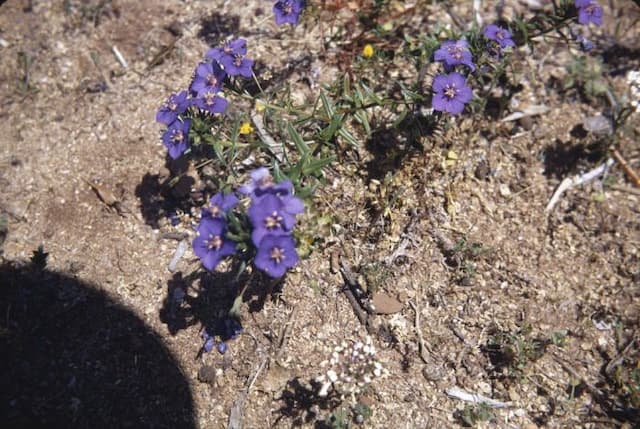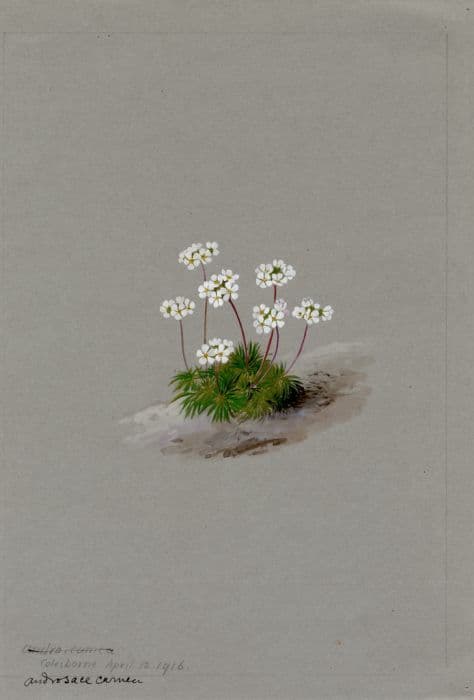Auricula Primula auricula 'Dusky Maiden' (Au/a)

ABOUT
Primula auricula 'Dusky Maiden' is a captivating plant notable for its ornate flowers and attractive foliage. The flowers of this variety present a rich, deep color palette, often described as a dusky or velvety maroon or burgundy. Each flower is comprised of circular petals arranged around a central eye that contrasts strikingly in color, typically displaying a bright yellow or golden hue. The petals may exhibit a delicate dusting of farina, which is a powdery substance that gives them a frosted appearance. The leaves of the 'Dusky Maiden' are likewise a key feature, with their fleshy texture and unique shape. They are typically a soft green color, sometimes with a hint of gray, forming a rosette pattern at the base of the plant. The foliage may also have a light coating of farina, contributing to the overall soft and muted appearance of the plant. The plant produces a robust display of flowers perched atop sturdy stems that rise from the center of the leaf rosettes. This characteristic bloom arrangement allows for an eye-catching display that draws attention in a garden setting. The plant's visual appeal is enhanced by the distinctive contrast between the rich flower colors and the backdrop of the velvety green foliage, making it a highly desirable variety for ornamental gardening.
About this plant
 Names
NamesFamily
Primulaceae
Synonyms
Bear's Ear, Mountain Cowslip, Auricula Primrose
Common names
Primula auricula 'Dusky Maiden'
 Toxicity
ToxicityTo humans
The plant known as Auricula is generally not considered toxic to humans. While it is not commonly associated with poisoning or serious side effects upon ingestion, it is still advisable not to eat the plant, as it is not meant for consumption. There may be a risk of mild stomach upset or an allergic reaction in some individuals if any part of the plant is ingested, but severe toxicity is rare.
To pets
The Auricula is not known to be toxic to pets. It does not typically pose a risk of serious poisoning if ingested by animals such as dogs or cats. However, as with any non-food plant, consumption of large quantities could potentially cause mild gastrointestinal upset, including vomiting or diarrhea. It's always best to prevent pets from eating any part of ornamental plants to avoid possible stomach discomfort.
 Characteristics
CharacteristicsLife cycle
Perennials
Foliage type
Evergreen
Color of leaves
Green
Flower color
Maroon
Height
6 inches (15 cm)
Spread
6 inches (15 cm)
Plant type
Herb
Hardiness zones
5
Native area
Europe
Benefits
 General Benefits
General Benefits- Ornamental Value: Primula auricula 'Dusky Maiden' adds aesthetic appeal to gardens with its distinctive deep purple flowers and contrasting golden yellow center.
- Compact Size: It is well-suited for small gardens or container growing due to its compact habit.
- Early Bloomer: As a spring bloomer, it provides early season color, often flowering from late winter through spring.
- Perennial Growth: Being a perennial, it comes back year after year, offering long-term value for gardeners.
- Attracts Pollinators: The flowers attract bees and butterflies, enhancing pollination in the garden.
- Low Maintenance: Requires minimal care once established, making it suitable for novice gardeners.
- Cold Hardy: The plant is relatively cold-hardy, able to withstand cooler temperatures and frost.
- Edging and Borders: Its neat growth habit makes it suitable for use in edging or as a border plant.
- Rock Gardens: Fits well into rock gardens due to its alpine origins and ability to grow in well-drained soil.
- Diversity: Introduces genetic diversity into garden spaces, which can help boost ecosystem health.
 Medical Properties
Medical PropertiesThis plant is not used for medical purposes.
 Air-purifying Qualities
Air-purifying QualitiesThis plant is not specifically known for air purifying qualities.
 Other Uses
Other Uses- The leaves of Primula auricula can be used in the preparation of natural dyes, giving wool and textiles a range of gentle hues.
- The flower petals are sometimes used in the crafting of natural confetti for celebrations due to their vibrant colors and biodegradability.
- Pressed auricula flowers can be utilized in botanical art and for decorating homemade cards or bookmarks for a unique and natural look.
- The plant's aesthetic appeal can enhance the ambiance in gardens designed specifically for visually-impaired individuals through its varied and vivid colors, contrasting with green foliage.
- During the Victorian era, auricula flowers were often featured in floral clocks—gardens laid out to show the time of day based on blooming patterns.
- As an edible flower, the blossoms of Primula auricula can be incorporated into salads or used as an edible garnish to add color and a mild, lettuce-like flavor.
- Auricula flowers can be crystallized with sugar and used to decorate cakes, desserts, or as a delicacy itself.
- In crafts, the sturdy leaves of the plant can be used to create botanical prints on fabric or paper for a unique texture and design.
- The unique appearance of auricula flowers may serve as inspiration for designers, giving rise to patterns and motifs in textile design.
- The plant's name and imagery could be utilized in literary and artistic symbolism, representing traits like resilience, rarity, and beauty in poems and artwork.
Interesting Facts
 Feng Shui
Feng ShuiThe Auricula is not used in Feng Shui practice.
 Zodiac Sign Compitability
Zodiac Sign CompitabilityThe Auricula is not used in astrology practice.
 Plant Symbolism
Plant Symbolism- Uniqueness: The 'Dusky Maiden' variety of Auricula, with its distinctive color, often signifies the uniqueness and individual beauty of a person or situation.
- Courage and Perseverance: Auriculas are known to grow in challenging alpine conditions, symbolizing the ability to overcome adversity.
- Cautious Love: In the Victorian language of flowers, auriculas were sometimes a symbol of delicate or cautious love, possibly due to the precise and intricate patterns on the petals.
- Patience: With a blooming season that requires patience, auriculas can represent the virtue of waiting for the right moment.
 Water
WaterFor the Bear's Ear, water should be done thoroughly but infrequently, allowing the soil to dry out slightly between watering sessions. This plant does not tolerate waterlogged conditions, so make sure it is planted in well-draining soil and in pots with drainage holes. During the active growth period in spring and summer, water approximately every 7 to 10 days with about 8-16 ounces of water, depending on the pot size and environmental conditions. Cut back on watering in the cooler, dormant months to prevent root rot, providing just enough to keep the soil from completely drying out.
 Light
LightBear's Ear thrives best in bright, indirect sunlight. The ideal spot would be an east or west-facing window where the plant is exposed to morning or evening sun but protected from the harsh afternoon rays. Too much direct sunlight can scorch the delicate leaves, while too little light can lead to weak growth and fewer flowers.
 Temperature
TemperatureThe ideal temperature range for the Bear's Ear is between 50 to 75 degrees Fahrenheit. It can survive even at minimum temperatures of around 40 degrees Fahrenheit but should be protected from frost. Maximum temperatures should not exceed 80 degrees Fahrenheit to maintain plant health and vitality.
 Pruning
PruningPruning the Bear's Ear is important to remove dead or fading flowers, which encourages the plant to produce new blooms and maintain a neat appearance. It’s best to prune right after the blooming period in late spring or early summer. Cut back the spent flower stems to the base of the plant. Additionally, remove any damaged or yellowing leaves as needed throughout the year.
 Cleaning
CleaningAs needed
 Soil
SoilThe Dusky Maiden Auricula prefers a well-draining soil mix composed of equal parts peat, loam, and leaf mold, with a handful of grit for improved drainage. The ideal pH for this Primula ranges from slightly acidic to neutral, typically between 6.0 and 7.0.
 Repotting
RepottingDusky Maiden Auricula should be repotted every one to two years to replenish the soil and accommodate root growth. Best done in late summer after flowering or in early autumn.
 Humidity & Misting
Humidity & MistingDusky Maiden Auricula thrives best in moderate humidity levels, but it is not too demanding. Aim for a humidity level around 50-60% for optimal growth conditions.
 Suitable locations
Suitable locationsIndoor
Place in bright, indirect light with moderate humidity.
Outdoor
Plant in partial shade, sheltered from strong winds.
Hardiness zone
4-8 USDA
 Life cycle
Life cycle'Dusky Maiden' Auricula (Primula auricula 'Dusky Maiden') begins its life cycle when seeds are sown in well-draining soil during late winter or early spring, often requiring stratification to break dormancy. Upon germination, seedlings develop a rosette of leaves close to the ground and require a period of growth before flowering. The plant will typically flower in the spring, producing intricate flowers with a velvety texture and a unique color range, often in shades of dusky pink and purple with a central eye of contrasting color. After flowering, the plant sets seed, which can be collected for propagation or allowed to self-sow if conditions are favorable. Throughout the summer, Auricula focuses on vegetative growth, storing energy for the next flowering cycle in its semi-evergreen foliage. As temperatures drop in autumn, the plant enters a state of dormancy, though in milder climates the foliage may persist, before re-emerging the following spring.
 Propogation
PropogationPropogation time
Spring-Early Summer
The most popular method of propagation for the Primula auricula 'Dusky Maiden', commonly known as Auricula, is through division. This is typically done in late summer after the blooming season has ended. The clumps of the plant are carefully dug up and gently pulled apart into smaller sections, ensuring that each section has some roots attached. These divisions are then planted into a well-draining soil mix at the same depth they were previously growing. It's important to water these new plantings thoroughly to help establish them in their new environment. This method of propagation allows gardeners to create new plants that are genetically identical to the parent plant and can lead to blooms in the following season.









